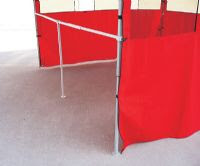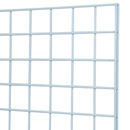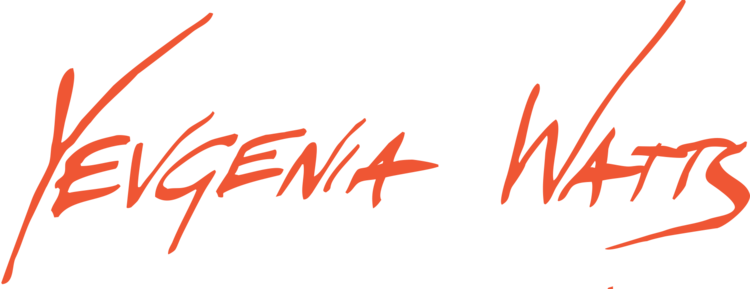I have something different today,
a guest blogger (who is my very own husband) :). This is a post he published last year, after creating out own art fair setup. It has served us faithfully through something close to 20 art fairs, farmer's markets and other events and it is still in good shape (unlike the Aaron Brother's frames that we got at the same time). Warm welcome to
:)
I mentioned in a previous blog that I'm not really a huge fan of most art. My wife and I have been married for over three years now and I think I can count the number of art events that I've attended with her on one hand (I know.. I'm a bad husband). But, I'm a changed man. No, I still don't care too much for the majority of the art, but mention a show and I'm in. Why's that? The booths.
I think my wife and I make a pretty good combo. I don't think that she could do, or would do, the business side of art by herself and I certainly can't make the artwork, but together, we're on our way towards making this a real business (granted, a very slow-growing one). So, whenever we do attend any kind of art event, or even just a street fair or swap meet, I've got my eyes open for new booth ideas. How to display product, how to interact with customers, what might sell and why, and try to apply those ideas to our own set-up. It was also through looking at other booths, both in person and online, that we found out what all we would need in order to create a professional looking booth of our own.
"One must have money to make money" - I always thought this old adage was more true than is convenient, but in this whole process, I've found that there is a loophole nowadays that goes something like this... "One must have CREDIT to make money".. I'm not sure of the financial wisdom of our business creation process, after all, we've basically taken a 9.9% APR loan for most everything that we've purchased. A smarter person with a more structured business plan might have simply applied for a small business loan but we used credit. Either way, here's what you can expect to spend to get started with a set-up similar to ours.
Canopy - the first and most important (and expensive) part of the set-up. Though you can buy a standard 10x10 pop-up shelter for quite cheap, the quality will be quite cheap as well. For the random event and light use, it may be fine, but we opted to go all out and get the professional version for durability (and to remind ourselves that this is a business, not a hobby). Our frame is the EZ-UP Eclipse II model which is $675 from EZ-UP Direct. Since we bought our frame from a friend without the top, we went through California Palms for the top and sides. Their prices are great, the fabric they use is thicker than most others and they offer their "four-seasons" top ($140) which has air vents in the fabric. This helps a bit with the heat but primarily allows the wind a place to escape without picking up and tossing our canopy.
Sidewalls are not a necessity per se, but I believe that it really completes the booth and gives it that professional look. They also block the sun, wind and rain, keeping your booth somewhat protected from the elements though they can increase the temperature inside the booth a bit. We leave one of the back corners open a bit to facilitate air flow. Our sidewalls ($280) were purchased from California Palms along with our top. Though their sidewall prices seemed a bit higher than the competitions, I am quite satisfied with them. They are flame-retardant. Each panel zips to the neighboring panel, but there is also an additinal strip of fabric that velcros the two together, providing extra strength.
Most fairs, shows and events require that you have a canopy and many require that it be white, so be cautious of buying one in a different color. Many municipalities also require that it be fire retardant. A typical booth space at an event is 10ft x 10ft so I recommend sticking to that standard size.

Tables & Chairs - We spent a surprising amount of time looking at various tables and sizes. Do we go with two 8 ft tables and one 6 ft, four 6 ft, etc. We wanted to have some freedom to mix and match so we could change our set-up as needed and neither of those options seemed great. Also, most tables were 30 inches wide, much wider than I thought we needed. Having one such table on each wall would mean that our "floor" space would be greatly reduced, making the booth feel smaller than it is without really giving more display room. Eventually, we found some great folding tables ($30) at Target and Walmart. They were 48" x 20", so they could be re-arranged however we wanted. They were narrow enough that they didn't take up too much floor space. They are light and fold down quite thin, yet are strong enough for what we are using them for. We even found a matching smaller folding table for my wife to place her easel and art supplies on for the shows. For table cloths, we went to the local fabric store and browsed their remnant and clearance racks. We found a wonderful blue fabric that my wife then made the tablecloths with. They look great and bring a bit of class to the set-up.
Chairs were easier to chose of course. We bought two folding chairs ($60) and a folding stool ($20). My wife usually works on the stool at her little painting table while the chairs are used for myself and anyone who stops by for an "on-the-spot" painting.
Print Racks - We needed a way to display our prints so we began searching the popular art catalogs. I was astounded by the costs of print racks! To be such a simple piece of equipment, the cost was really high. So, being the cheap (wait, I mean "money-concious") person that I am, I decided to just make my own. I went to Lowes and purchased some 1" x 2" Redwood boards, some brass screws, brass chain, stuff to make the pivot point and stopped at Wal-Mart to buy some black canvas (should have gone with white). A few cuts and screws later and the frame was made. Genia was sick of sewing table cloths by that point, so I cut and made the canvas part myself and affixed it with brass screws. Easy job (about $20 each). We made that one large enough to hold our largest prints which are 24" x 30" matted.
For the smaller prints, I decided that an elegant display solution would be to use tempered-glass display cases. The glass panels are available for purchase individually so you can create whatever size you want. Here is a website that lists the available sizes and prices. Overall, they were cheap and easy and do a nice job and displaying everything up to 16" x 20" matted. ($15-$20 each).

Side-wall Display - Since we wanted to display framed originals and some of our larger prints on the walls of the booth, we had to come up with an easy way to "build a wall" to hang stuff on. While I was browsing through the Calfornia Palms website, I came across some frame-rails ($50 each, must request rail only). These are basically a "T"-rail that connects between two canopy legs. My first thought was that this could be a great way to provide some stability to the canopy to help deal with the heavy winds we get here, so I bought three. Then, I came across a product called grid panel ($11.50 each) which we could

affix to the canopy and the frame-rails to give us our "wall" to hang pictures on. Grid panel, being steel wire, is quite heavy, so it was nice only having to buy 2' x 4' sections which sit on top of the frame-rail. We purchased 12 panels total, four for each wall. Lastly, we bought some grid-panel hooks that are great for hanging pictures from.
After a few uses, we found out that putting the grid-panels up and taking them down took longer than any other part of the booth set-up. So, I decided to simplify things a bit by using zip-ties to connect each set of two panels together. This meant only having to make six trips instead of twelve. I also bought a roll of Velcro One-Wrap to make some velcro fasteners for the grid-panel. I used two where the grid-panels connects to the top of the canopy, and three where it attaches to the frame-rails. Now, I can take the grid-panel off and leave the fastening system attached. Saves quite a bit of time and zip-ties.
Other Stuff - We decided that fine art greeting cards might be a good product to sell, so we purchased a 48 slot card rack ($49) from RobertHam.com. Its nice and light, assembles and disassembles very quick and does a nice job at displaying our cards.
We bought our picture frames (appx $250) from Aaron Bros, using their 40% off-coupon. Unfortuately, those coupons are only good for one item, per person, per day so we spent about three days going to all of the Aaron Bros in town to get the amount of frames that we needed (did I mention that I'm money-concious?). We still aren't sure we like the ones we bought however. They look pretty good, but the frames have a tendancy to scratch easily. Regardless of what you get, I recommend cutting some cardboard "spacers" to go in between frames when they are packed for storage or transport.
If you don't have a bag for your canopy, I highly recommend one. Our canopy bag ($50) is one of the rolling type, which I also highly recommend, especially if you followed my example and bought an expensive, professional canopy. It turns out that "expensive" is synonymous with "heavy" as our canopy weights in at over 75lbs. Wheels make transporting it much easier and it also protects the top from damage.

We purchased a canopy awning ($88) along with our the other items we got from California Palms. While it is not an essential item, we felt that it would entice more people to visit, or at least loiter in front of our booth by providing a bit of shade on those warm days. It does seem to work for that purpose and it also provides some extra sun protection for the artwork, especially since the print rack and card rack sit out from under the main canopy. With concerns of wind damage, I made some braces for the awning that should help to hold up to most of what we get up here.
Oh! Almost forgot the sand bags... If you will be showing in an area that occasionally gets even moderate wind, you'll definately want to invest in some good sand/weight bags for your canopy. There are a number of different styles out there. We opted to go, yet again, with California Palms. Their weight bags ($50 for 4) are made of heavy duty canvas with velcro on the sides to hold it to the canopy legs. What I like about them is that they already have the straps attached to fasten them to the top of the canopy frame. This means that you don't have to worry about bringing extra straps along and with these being nylon, they wont stretch and allow the canopy to move like bungie cords do.
Two more things that are helpful, though not essential, are some big storage boxes ($20 each) that we bought from Lowes and a hand truck ($100) we bought from Costco. The storage boxes provide an easy way to keep all of our prints, cases, accessories, etc together in one place, and makes for only two trips to the van instead of half a dozen, and the hand truck is great for those events where you can't drive up to your space to unload.
One last thing... The van. We have Subaru Outback that we used once to transport all of our stuff with. Granted, we had our son with us, but even without him, we would have had to strap stuff to the roof. As such, we've invested in a 1997 Chevy Astro Van. They are pretty reasonable to find used, have a great amount of cargo space (we leave the middle bench seat in and still have enough room) and drive pretty much like a car. We considered getting a full-size van, but my wife wouldn't have felt comfortable driving and parking something that large.
Art shows, fairs, swap-meets, exhibitions seem to be a part of life when it comes to starting out as a professional artist. While it can be boring and tedious, not to mention discouraging at times, you can improve your chances by having a professional looking booth set-up.
So, there it is, all (or most) of what you'll need to create a decent looking booth set-up.
Total Cost (minus the van) - appx $2,000
